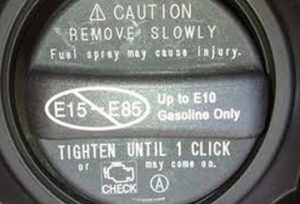 You may have noticed that a number of new cars have a graphic image placed right on the gas cap that states: “E15—E85 – Up to E10 Gasoline Only.” The “E15—E85” text is placed inside an oval and has a slash mark cutting through it. That means the automaker is recommending you don’t use E15 gasoline (or anything higher up to E85, which is the amount used in flex-fuel vehicles) in your tank, and stick with the blend wall that’s in nearly all US gas stations – up to 10% ethanol in the gasoline, or E10. The US Environmental Protection Agency (EPA) had been pushing for E15 with the support of ethanol producers and against the lobbying efforts of oil companies and refineries. Automakers haven’t been fighting ethanol producers in Washington like oil company have been, but they have been warning about the potentially corrosive damaging effects of E15 on engines. The new EPA ruling, released on Friday, doesn’t explicitly speak to the E10 versus E15 debate; the agency appears to be accepting that E10 is as good as it gets for now.
You may have noticed that a number of new cars have a graphic image placed right on the gas cap that states: “E15—E85 – Up to E10 Gasoline Only.” The “E15—E85” text is placed inside an oval and has a slash mark cutting through it. That means the automaker is recommending you don’t use E15 gasoline (or anything higher up to E85, which is the amount used in flex-fuel vehicles) in your tank, and stick with the blend wall that’s in nearly all US gas stations – up to 10% ethanol in the gasoline, or E10. The US Environmental Protection Agency (EPA) had been pushing for E15 with the support of ethanol producers and against the lobbying efforts of oil companies and refineries. Automakers haven’t been fighting ethanol producers in Washington like oil company have been, but they have been warning about the potentially corrosive damaging effects of E15 on engines. The new EPA ruling, released on Friday, doesn’t explicitly speak to the E10 versus E15 debate; the agency appears to be accepting that E10 is as good as it gets for now.
The new EPA ruling caps renewable fuel targets for 2014 at 15.21 billion gallons – instead of the 18.15 billion gallon target that Congress had originally set in 2007 with its Renewable Fuel Standard. The EPA says its accepting the E10 blend wall for now because advances in fuel economy and other economic factors have pushed gasoline consumption to a much lower level than expected when the standard was passed in 2007. “As a result, we are now at the E10 blend wall,” EPA said in a statement.
The 15.21 billion gallon ceiling is also below the 16.55 billion gallon requirement for this year. Corn-based ethanol makes up the lion’s share of that total – it’s limited to 13 billion of next year’s total and 13.8 billion for this year. The limitations on corn ethanol have also been influenced by the amount of corn grown in the US that will end up in gas tanks versus food. Ethanol is expected to use up 38% of the corn crop this year. Cellulosic ethanol is also seeing cuts in volume for next year with the EPA’s revised ruling. Cellulosic and other next-generation biofuels, made from agricultural waste such as wood chips and corncobs, have not taken off as quickly as Congress had built into the 2007 act.
Oil companies and refineries weren’t thrilled with the EPA decision and may still continue to fight the Renewable Fuel Standard, but the groups were pretty much satisfied with the EPA’s decision on the E10 blend wall. Farmers and corn ethanol producers were angry about it, arguing that mixing higher blends of ethanol will not harm vehicles. The EPA has given in to “big oil.” The EPA’s revised targets will hurt farmers and violate the spirit of the Renewable Fuel Standard, according to Bob Dineen, president of the Renewable Fuels Association. “They’re capitulating to the oil companies,” Dineen said to The Washington Post.
Ethanol producers had disputed an Associated Press investigation released earlier last week that linked corn-based fuel production to environmental hazards. Ethanol groups attacked the accuracy of the AP findings for using dubious tactics while conducting the investigation for its report. The AP investigation report stated that the surge to find new areas to plant corn for the needed ethanol had eliminated five million acres of conservation land, destroyed natural habitat, and polluted water supplies.
The oil versus biofuels industry battle highlights the struggle nearly every alternative fuel faces. The arguments speak to environmental, safety, reliability, and economic issues. It’s very difficult to sift through all the lobbying messages, studies, and media reports to determine accuracy. For people buying the vehicles and fuels, it’s tough to make an informed decision and trust that it’s accurate. As an example, an argument comes up occasionally about the logic of buying an electric vehicle when the source of the energy (especially coal-powered electric power plants) takes away the gains offered by the zero emissions vehicle. All of the clean transportation vehicles, fuels, and technologies are in a transitional phase – none of them are perfect and their advocates usually support a pragmatic approach that is likely to lead to a better option years from now. A number of biofuels advocates, including the EPA, say that using corn-based ethanol in E15 is a step forward away from gasoline consumption and is necessary to transition over to advanced biofuels. For now, the EPA is stepping back from its earlier mandate.



